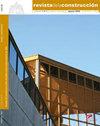Mechanical performance of 100% recycled aggregate concrete (RAC) bricks
IF 1.4
4区 工程技术
引用次数: 0
Abstract
Urbanization and modern development of expanding infrastructure have resulted in large construction activities. With the expeditious growth in the construction industry, the rate of demolition has also increased. This is causing considerable increase in Construction and Demolition (C&D) waste all around the globe. To minimize its impact on society and environment, preventive measures are required to be taken on urgent basis, and for this reason construction industry has proposed the use of recycle concrete aggregates in different applications and there is dire need to investigate experimentally the properties of concrete products made using Recycled Aggregate Concrete (RAC). In this regard, this study focused to investigate the mechanical properties of 100% RAC bricks prepared with two different compositions with respect to coarse to fine aggregates ratio (i.e., 70:30 and 60:40), cement dosage (i.e., 10% and 15% by weight of total aggregates) and casting pressure (i.e., 25 MPa and 35 MPa). Recycled concrete aggregates required for this study were produced by crushing tested concrete samples having compressive strength of 21 MPa to 28 MPa. Mechanical tests were performed on bricks to determine their compressive strength, flexural strength, shear strength, impact energy in compression and flexure. In addition to these destructive tests, non-destructive (rebound hammer and ultra-sonic pulse velocity) tests were also performed. To draft a comparison, Natural Aggregate Concrete (NAC) bricks and first class burnt clay bricks were also tested. The results indicated that the compressive strength of NAC bricks was about 30% higher than the compressive strength of RAC bricks. However, RAC bricks exhibited higher compressive strength as compared to burnt-clay bricks. The flexural strength of RAC bricks containing 60% coarse aggregates and 40% fine aggregates and RAC bricks containing 70% coarse aggregates and 30% fine aggregates was found to be almost similar but their flexure strength was 37.3% and 20.7% lesser than their corresponding NAC bricks. Flexure strength of RAC bricks and burnt clay bricks was found to be almost same. Qualitative assessment by ultrasonic pulse velocity (UPV) tests showed that the NAC and RAC bricks were of good quality as per the standard criteria. The findings of this study indicated that RAC bricks satisfied the strength requirements as stated by local and international standards. Further, RAC bricks performed better than commonly used first class burnt clay bricks. Production and use of RAC bricks in masonry structures will not only help to conserve the depleting resources of natural aggregates and clay but also help to protect our environment from pollution by reducing CO2 emission caused by the coal-burning as fuel in kilns for the manufacturing of burnt-clay bricks.100%再生骨料混凝土(RAC)砖的机械性能
城市化和不断扩大的基础设施的现代化发展导致了大规模的建筑活动。随着建筑业的快速发展,拆迁的速度也在增加。这导致了全球范围内建筑和拆除(C&D)浪费的大幅增加。为了最大限度地减少其对社会和环境的影响,迫切需要采取预防措施,因此建筑行业已经提出在不同的应用中使用再生混凝土骨料,并且迫切需要对使用再生骨料混凝土(RAC)制成的混凝土产品的性能进行实验研究。在这方面,本研究着重研究了两种不同成分制备的100% RAC砖在粗细骨料比(即70:30和60:40)、水泥用量(即总骨料重量的10%和15%)和浇注压力(即25 MPa和35 MPa)方面的力学性能。本研究所需的再生混凝土骨料是通过破碎抗压强度为21 ~ 28 MPa的试验混凝土样品生产的。对砖进行了力学试验,以确定其抗压强度、抗折强度、抗剪强度、抗压和抗折冲击能。除了这些破坏性试验外,还进行了非破坏性(反弹锤和超声波脉冲速度)试验。为了进行比较,还对天然骨料混凝土砖和一级烧成粘土砖进行了试验。结果表明,NAC砖的抗压强度比RAC砖的抗压强度高30%左右。然而,RAC砖表现出更高的抗压强度相比,烧粘土砖。含60%粗集料和40%细集料的RAC砖与含70%粗集料和30%细集料的RAC砖的抗折强度基本相同,但其抗折强度分别比NAC砖低37.3%和20.7%。发现RAC砖与烧成粘土砖的抗弯强度基本相同。超声脉冲速度(UPV)定性评价表明,NAC和RAC砖的质量符合标准。研究结果表明,RAC砖满足国内和国际标准规定的强度要求。此外,RAC砖的性能优于常用的一级烧制粘土砖。在砖石结构中生产和使用RAC砖,不仅有助于节约消耗的天然骨料和粘土资源,而且还有助于保护我们的环境免受污染,因为它减少了在烧制烧粘土砖的窑炉中燃烧煤作为燃料所产生的二氧化碳排放。
本文章由计算机程序翻译,如有差异,请以英文原文为准。
求助全文
约1分钟内获得全文
求助全文
来源期刊

Revista de la Construccion
工程技术-工程:土木
CiteScore
2.30
自引率
21.40%
发文量
0
期刊介绍:
The Journal of Construction is aimed at professionals, constructors, academics, researchers, companies, architects, engineers, and anyone who wishes to expand and update their knowledge about construction. We therefore invite all researchers, academics, and professionals to send their contributions for assessment and possible publication in this journal. The publications are free of publication charges.
OBJECTIVES
The objectives of the Journal of Construction are:
1. To disseminate new knowledge in all areas related to construction (Building, Civil Works, Materials, Business, Education, etc.).
2. To provide professionals in the area with material for discussion to refresh and update their knowledge.
3. To disseminate new applied technologies in construction nationally and internationally.
4. To provide national and foreign academics with an internationally endorsed medium in which to share their knowledge and debate the topics raised.
 求助内容:
求助内容: 应助结果提醒方式:
应助结果提醒方式:


